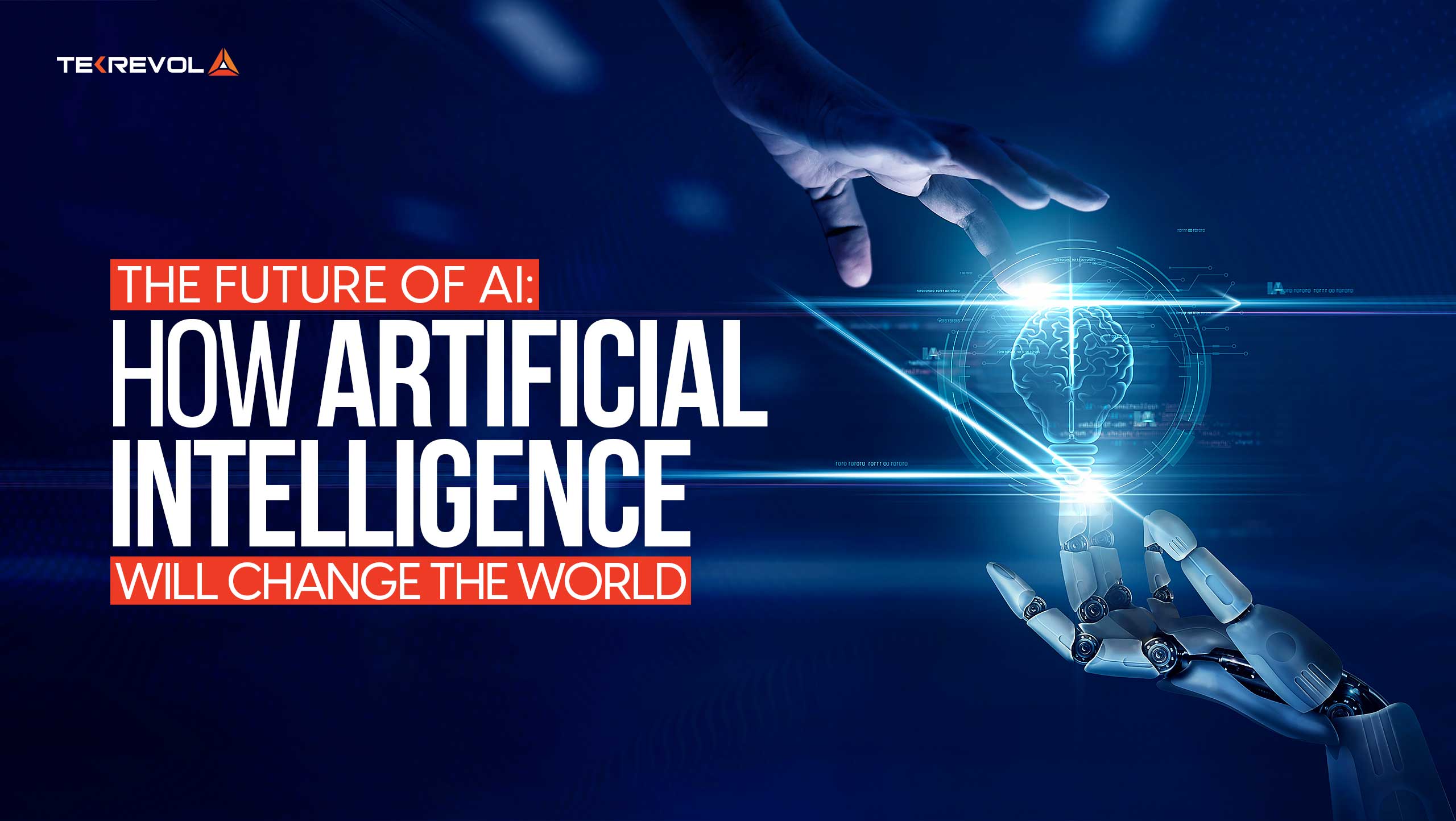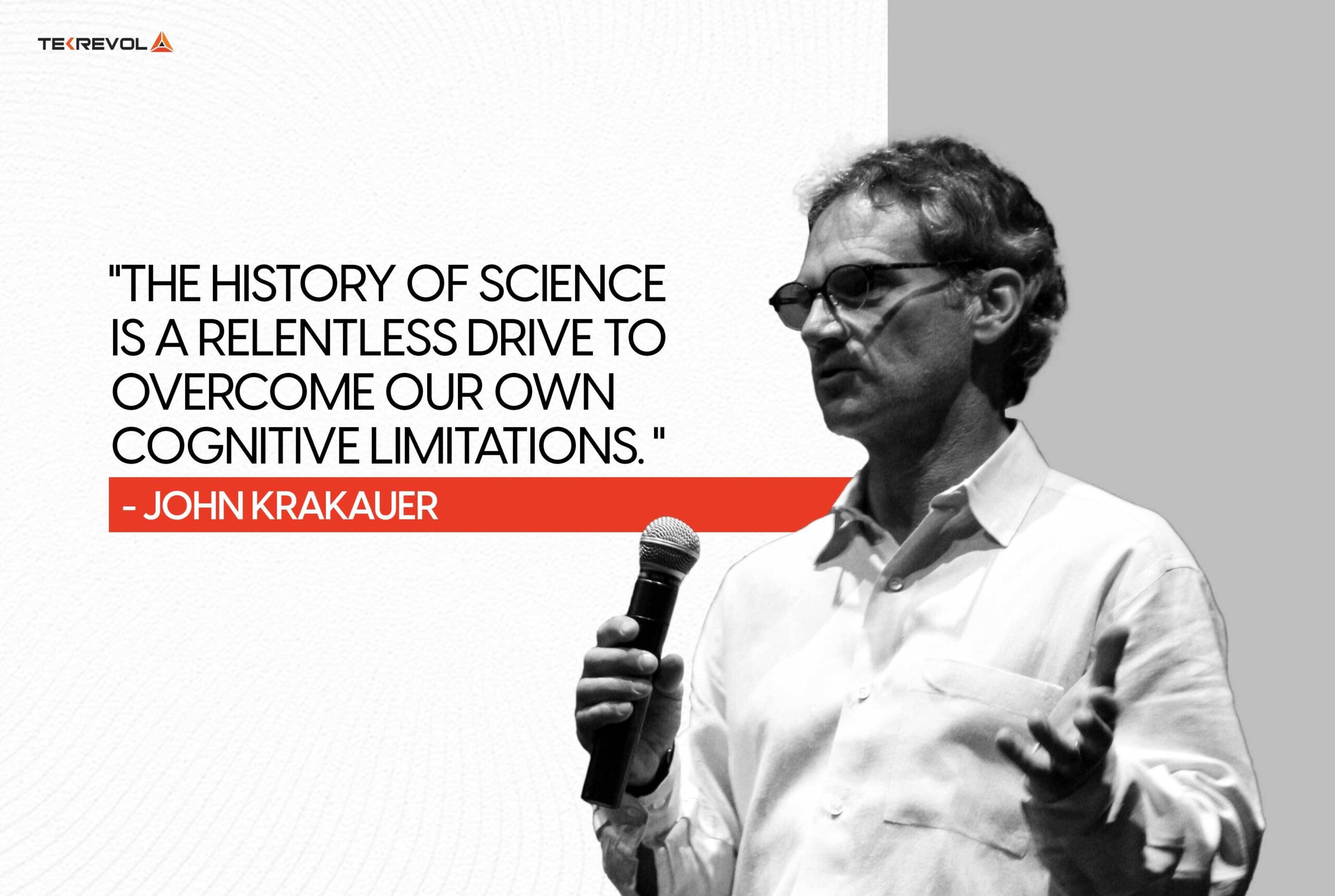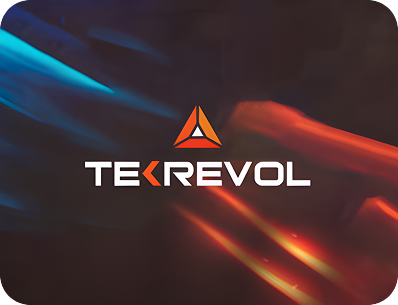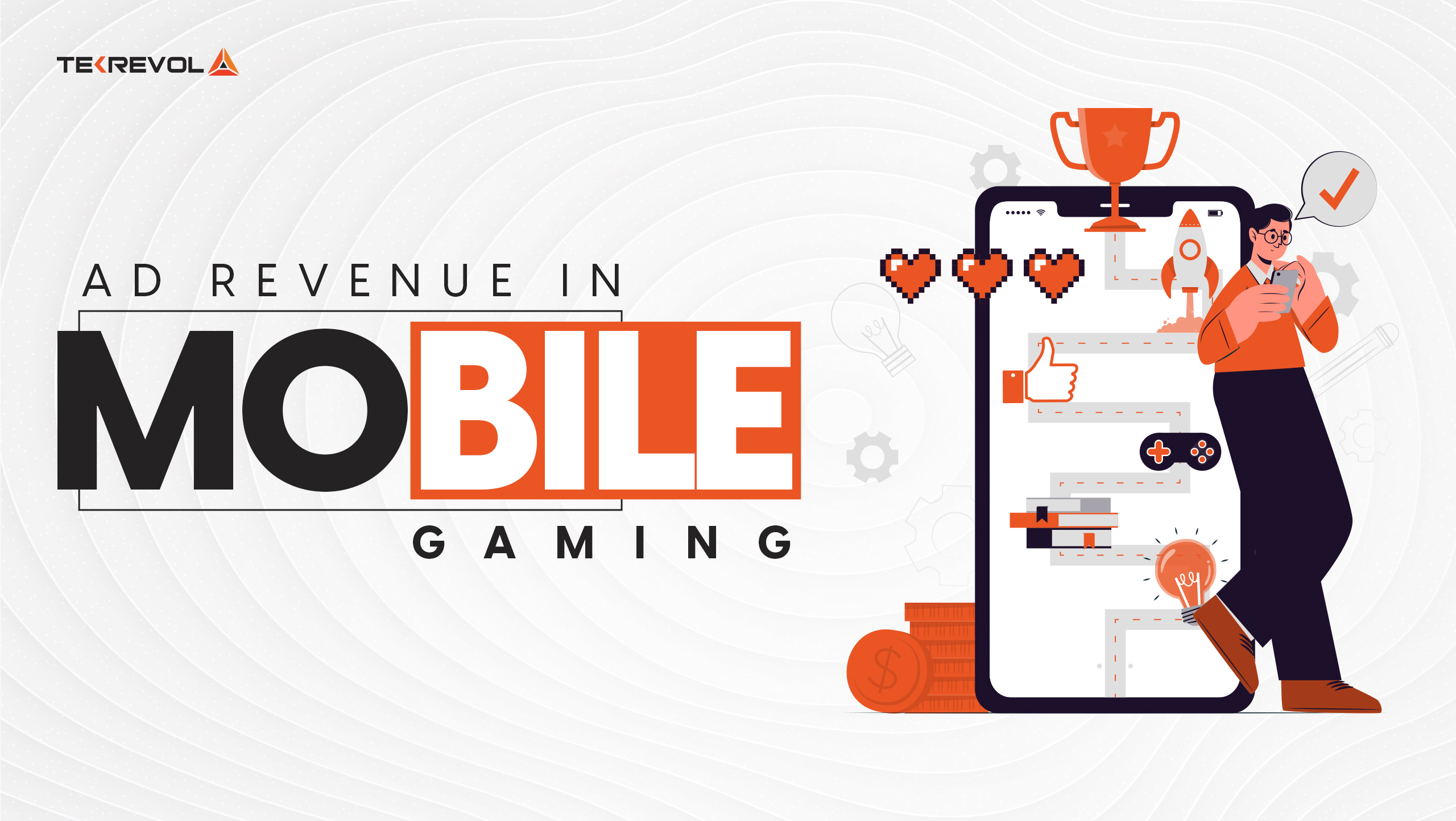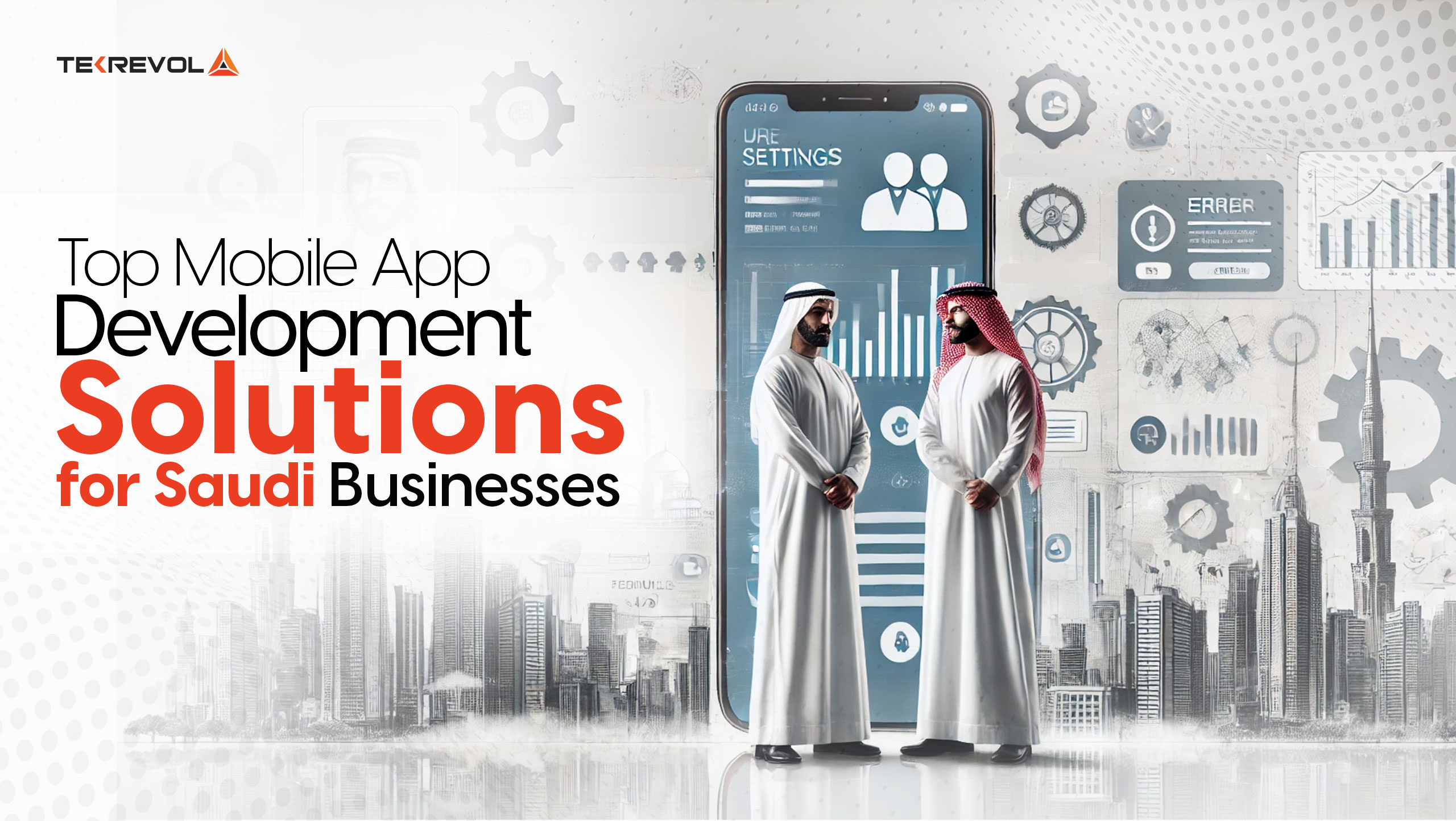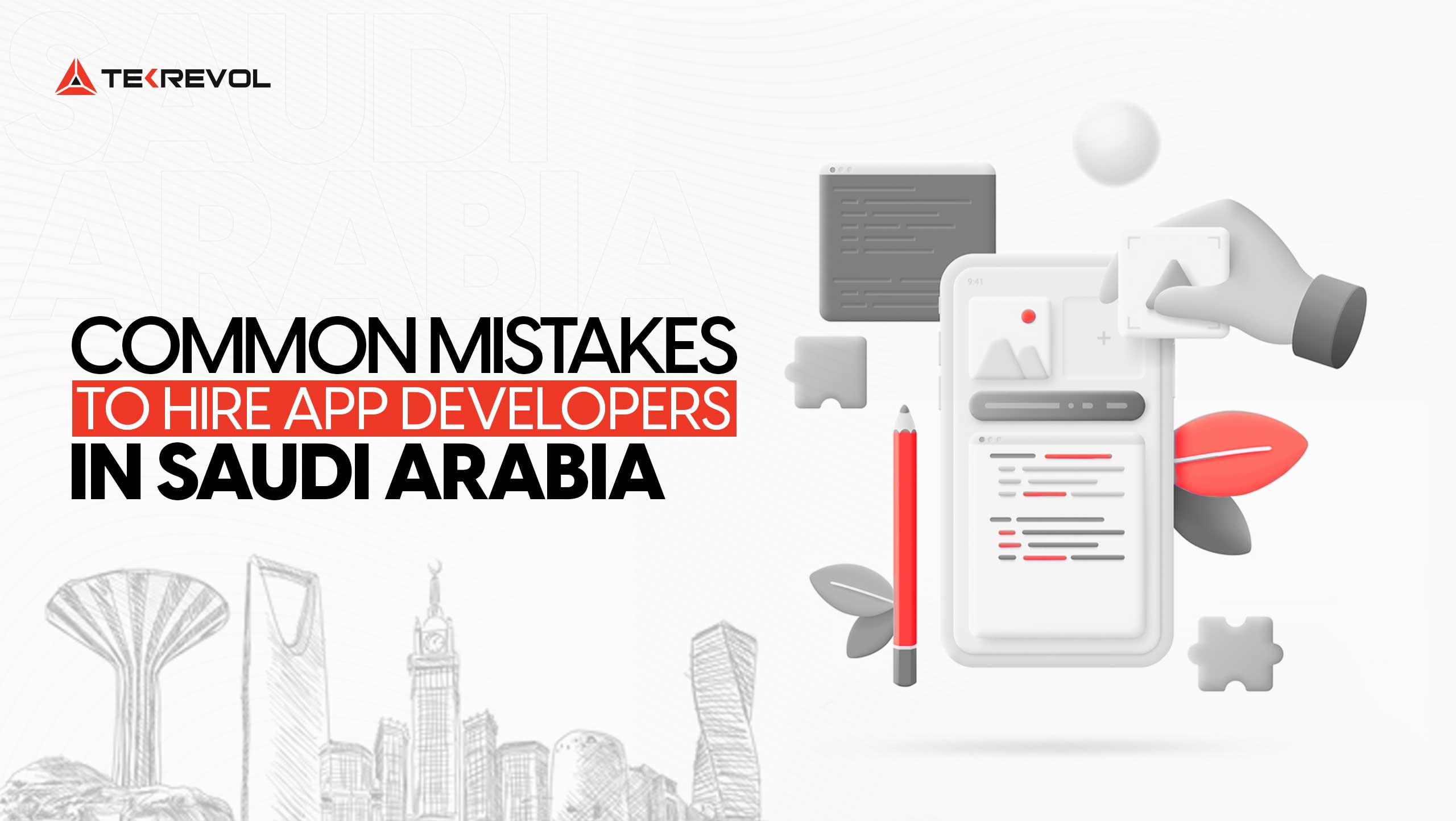AI is everywhere.
It is part of our lives now. When was the last time you read the tech section in your favorite magazine without an AI development in it? Technology pundits cannot stop predicting the future of this breathtaking technology.
The ongoing debate about AI’s future boils down to two major opinions. Some predict a utopian future where AI makes our lives easier. At the same time, others foresee a dystopia where AI takes over and wreaks havoc on humankind.
But the reality lies somewhere in between.
AI is already reshaping workplaces and redefining how we work, live, and interact. AI frameworks are guiding your voice assistants. Powerful machine learning algorithms fuel your self-driving Tesla cars. Amazon’s Gen AI personalizes your product suggestions based on your preferences. Apple Intelligence takes personalization and content creation to the next level.
But as this technology evolves, it’s crucial to separate fiction from reality. The idea is to understand the long-term impact of AI on business and society.
This article dissects the future of AI, busts some popular myths about AI, and helps you predict what’s next.
The Evolution Of Artificial Intelligence
Quick Question – Since when do you think Artificial Intelligence (AI) has been around? 2022? 2010? Not even close.
Well, you might scratch your head learning that the roots of AI go back to as early as the 1950s. Yes, you read it right. It was in the 1950s when John McCarthy coined the term “Artificial Intelligence.” he defined AI as “the science and engineering of making intelligent machines.”
This was the foundation of the decade of research and innovation, and the rest is history. Here’s what the timeline of the developments of AI looked like:
Phase 1: The Yearly Years (1950s-1980s)
In its earlier days, Artificial Intelligence was more of a concept than a reality. Researchers like Alan Turing, Marvin Minsky, and John McCarthy explored ways to create machines that could think and learn like humans.
The first AI program, called Logical Theorist, was developed in 1956. However, progress was slow due to limited computing power and lack of data.
Some notable milestones during this phase include:
- 1965: The first chatbot, ELIZA, was developed to simulate human-like conversations.
- 1970: The first AI-powered robot, Shakey, was built to perform tasks autonomously.
Phase 2: The Rule-Based Era (1980s – 2000s)
In the 1980s, AI made significant progress with the introduction of rule-based systems. These systems used pre-defined rules to make intelligent decisions. This is what makes AI more practical for real-world applications.
Key highlights of this phase include:
- 1981: The first expert system, MYCIN, was developed to diagnose bacterial infections.
- 1997: IBM’s Deep Blue defeated chess grandmaster Garry Kasparov, marking a major AI milestone.
Phase 3: The Machine Learning Era (2000s – present)
The 21st century saw a surge in AI development thanks to the rise of machine learning and deep learning. This enabled AI systems to learn from data and improve over time.
This phase marked the following key AI advancements:
- 2011: IBM’s Watson won Jeopardy!, demonstrating AI’s ability to process natural language.
- 2018: OpenAI released its first GPT model, revolutionizing natural language processing.
- 2022: ChatGPT was released, marking a significant milestone in conversational AI.
- 2023: Generative AI and multimodal AI became increasingly popular. Companies like Anthropic and Open AI lead the charge.
- 2024: AI trends, including Apple AI, emphasize trustworthy AI solutions. The rise of edge AI and enhanced AI-human duo to drive innovation and ethical use.
The latest surge in AI adoption is largely attributed to the release of ChatGPT. It has made AI more accessible and user-friendly. Moving ahead, it’s exciting to think about AI’s possibilities for growth and innovation.
Interested in Innovative App Designs? Read More: Everything You Need to Know About AR Zone App
How Will AI Change The World?
AI is the latest synonym of innovation. In the last two years, AI has transitioned from an emerging tech to an everyday essential. It is now the driving factor behind next-gen technologies like Edge AI, Big Data, IoT, and Robotics.
Thus, the adoption of AI becomes inevitable. An IBM Survey suggests that 42% of enterprise-scale businesses have already integrated AI into their operations. Likewise, 65% of organizations regularly used Gen AI in 2025 (McKinsey 2025).
This is nearly double the percentage from their previous survey ten months ago. It tells about the speed of disruptive change AI is bringing to businesses.
With so much happening in front of our eyes so quickly, many wonder what tomorrow will look like. Here’s what the tech experts believe the future of AI would be:
AI In Daily Lifes
AI is already influencing our daily choices, and soon, it will become an inseparable part of our lives. After Siri, Alexa, and ChatGPT, the future will bring hyper-personalized AI bots. You will have an AI that can imitate you, understand you, and assist with your chores.
AI will become a must-have part of everything you do. The content you consume, the food that you order online, and the app you interact with will have AI embedded in it. The democratization of AI will ensure that everyone has equal access to AI and other things.
In short, AI will enhance your productivity, creativity, and cognitive ability. It will open new employment and earning streams. But it comes with a cost. That is, data privacy issues will become common. With companies using large volumes of data to train AI, these issues will take the central stage.
Wonder What Software Will Dictate Our Future? Read More on: 18 Types of Software Development that Will Dominate 2025 and Beyond
AI And The Future Of Work
AI is transforming the world of work, and the impact can be felt across industries and age groups. Whether you are a Gen Z born after the 2000s or a Baby Boomer who grew up watching sci-fi comics, AI is here for everyone.
AI’s biggest strengths lie in its massive computing power and generational abilities. Business leaders can now use AI to accelerate their decisions, saving huge resources. With 55% of companies reporting enhanced outcomes, the dream of business automation is finally becoming a reality.
This will give birth to a wide range of Generative AI solutions. In the future, we will have an AI solution for everything. AI-powered tools will streamline tasks and help perform creativity, strategic, and high-value tasks.
However, this also means that AI literacy will become a must. As AI evolves, workers must develop skills that complement AI capabilities.
From AI in business to the future of work with AI, the possibilities are endless. And like everything else, early adopters will always have a huge advantage.
- Looking to future-proof your business with AI?
- Get expert insights and solutions from a trusted AI partner. We help you stay ahead in the AI-driven world.
What Will Govern The Future of AI?
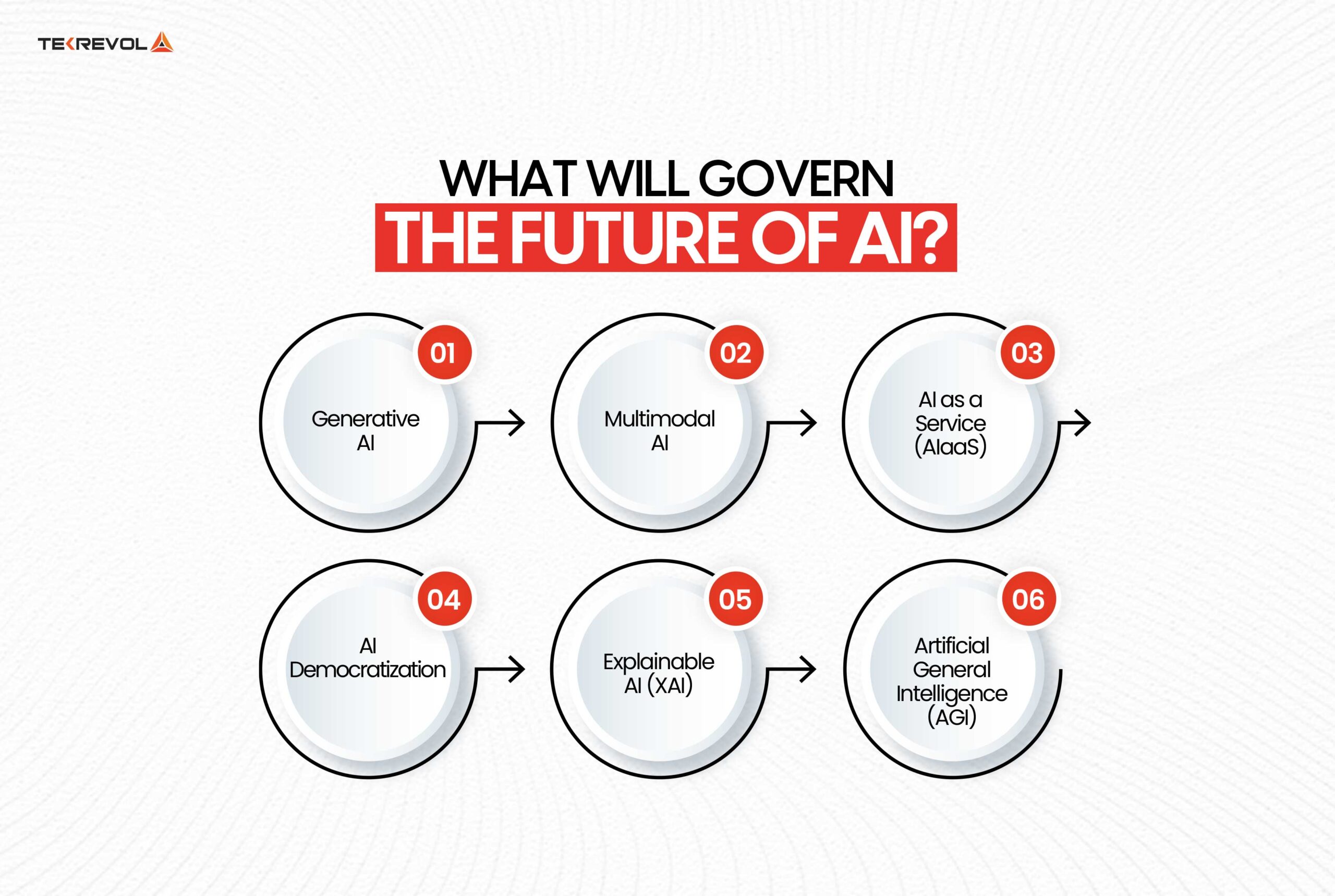
Will AI become smarter than humans? Will it create or destroy more jobs? Would there be regulations to control its growth? These are some of the questions on everyone’s mind about the future of AI.
While no one can tell for sure how it will all unfold, key trends are shaping AI development. Let’s look at the most important ones that are evolving right now.
Generative AI
2023 was the year the world was introduced to Generative AI, and the rest is history. This is the most talked-about application of AI, making ripples across industries. Whether writing copy, generating art, or even composing music, Gen AI is fueling creativity like never before.
Over the years, we expect more human-like creativity and intuition from these tools. In the future, Gen AI will be able to write complete scripts, develop no-code solutions, and even do more.
Some cutting-edge Generative AI models include:
- GPT-4 (OpenAI
- Claude 3.5 (Anthropic).
- Gemini 1.5 (Google):
- DALL-E 3
- Llama-3
Multimodal AI
Those apps that let you design your dream car by simply describing it? Or the viral videos that bring historical figures back to life? That’s all thanks to Multimodal AI. In less than a few years, Multimodal AI has leaped from producing pixelated images to near-realistic HD videos.
Multimodal AI uses NLP, image and video analysis, and speech learning algorithms. The result? AI that can read extensive reports, watch videos, and recreate both. This tech is already being used across use cases. Virtual assistants, smart classrooms, and healthcare, to name a few.
Thanks to Multimodal AI, doctors can analyze medical records and imaging in one go.
The future of multimodal AI is bright. As tech evolves, these AI development services are expected to bridge the gap between human and machine interactions. This will lead to more intuitive and efficient AI systems.
Some recent models that shine in Multimodal AI:
- GPT-4o (OpenAI)
- Gemini (Google)
- Midjourney, Inc
- Flamingo (DeepMind)
AI as a Service (AIaaS)
AI as a Service is a relevantly new concept. The idea is to develop off-the-shelf AI tools that help implement and scale their AI systems. The kicker here is that cost. AIaaS enables companies to explore AI at a fraction of the cost compared to in-house AI.
In the future, AI as a Service (AIaaS) as a trend will get more traction. This will create a level playing field for enterprises, SMBs, and startups to tap into the power of AI.
Moving forward, we expect faster and broader AI adoption as more industries recognize the benefits of renting AI rather than building it.
Some leading AIaaS platforms:
- Amazon SageMaker
- Google Cloud AI
- Microsoft Azure AI
- IBM Watson
AI Democratization
Making AI tools and resources available to everyone is a big deal, and this is where AI democratization comes in. Today, more than ever, AI is becoming accessible to non-experts. You don’t need to be a programmer to create an AI-powered chatbot or generate an image with AI.
In the future, we expect more open-source AI tools and resources designed for the everyday person. From “no-code” platforms to AI learning resources in schools, the future is about making sure that AI isn’t just for techies but for everyone.
Some platforms promoting AI democratization:
- Hugging Face: An open platform for sharing AI models and tools.
- Runway ML: Provides accessible AI tools for creatives.
- Kaggle: A wide variety of open-source datasets for data scientists and AI engineers.
- Google Colab: A free platform that lets users experiment with AI and machine learning.
Explainable AI (XAI)
AI is getting smarter, but understanding how it makes decisions is still tricky. That’s where Explainable AI (XAI) comes into play. It’s all about making AI’s decisions more transparent, so people can understand and trust them. This is crucial in sensitive fields like healthcare and defense, where human lives are at stake.
As AI systems become more integrated into everyday life, the need for transparency will only grow. We’re already seeing XAI being adopted in regulated industries, and it’ll likely become a requirement across more sectors soon.
Some leading approaches in Explainable AI:
- LIME (Local Interpretable Model-agnostic Explanations): Breaks down complex AI decisions into understandable chunks.
- SHAP (SHapley Additive exPlanations): Helps explain the contribution of each feature in AI decisions.
- Counterfactual Explanations: Shows what would happen if the input were different.
Artificial General Intelligence (AGI)
Now, here’s the big one—Artificial General Intelligence (AGI). Imagine a machine that can perform any intellectual task a human can. This might include writing essays, solving scientific problems, and more. AGI is the dream and the most elusive goal of AI research.
While we’re far from achieving true AGI, the research is advancing. AGI would not only be able to learn specific tasks but think, reason, and adapt across a wide range of fields, much like a human.
With this, however, comes a massive ethical debate about the control and impact of such systems.
- Are You Ready for the Future of AI?
- We specialize in creating cutting-edge AI solutions for businesses of all sizes.
Impact Of AI On Key Industries

When NVIDIA’s CEO Jensen Huang said, “AI is the most powerful force of our time.” We couldn’t all agree more. Artificial intelligence is reshaping entire industries, and we are witnessing an AI revolution in front of our eyes.
Recent reports show the global AI market could reach $407 billion by 2027. These figures highlight AI’s growing influence, from improving efficiency to creating new business models. The question isn’t if industries will adopt AI but how soon and to what extent.
Let’s take a closer look at AI’s impact across key industries and see how it’s driving changes in everything from healthcare to customer service.
AI In Healthcare
AI is transforming healthcare by improving diagnostics, enhancing treatment options, and enabling personalized medicine. Algorithms are now able to detect diseases like cancer faster than human doctors. For example, AI in diagnostics can identify early signs of breast cancer with 98.95% accuracy.
In support of this, initiatives like Pinktober at TekRevol are raising awareness and empowering individuals in the fight against breast cancer
Companies like IBM Watson are using AI in medicine to speed up drug discovery, cutting research time from years to months. So, what is the future of AI in healthcare? Expect breakthroughs in AI in drug discovery, as well as tools that help predict patient outcomes with precision.
AI In Education
The classroom is evolving, and AI is leading the way. AI in edtech tools like Coursera uses machine learning to tailor courses to each student’s learning style, making education more accessible and effective.
Meanwhile, AI in classrooms is lightening the administrative burden, allowing teachers to focus more on students. Studies predict that the future of AI in education will involve smart tutors that adapt in real-time, making personalized learning the norm.
With AI, students could soon have their digital assistant guiding them through their academic journey.
AI In Finance
The finance sector has fully embraced AI to enhance security, optimize trading, and improve customer service. AI in fintech is now being used to detect fraudulent transactions in milliseconds, with AI-powered systems saving banks billions. Algorithms are also driving innovations in AI in banking, helping with loan approvals and risk assessments.
Looking ahead, AI in finance will likely take on bigger roles in robo-advising, making personalized financial advice available to everyone. It’s no longer just the big banks benefitting from these advancements; fintech startups are, too.
AI In Manufacturing
The rise of AI in manufacturing is all about increasing efficiency and reducing downtime. With industrial AI, factories use AI-powered robots and predictive maintenance tools to keep machines running smoothly.
For instance, General Electric uses AI for smart factories, allowing them to predict when a machine will fail before it happens. The global manufacturing AI market is projected to grow at a CAGR of 57.2% annually. Factories are moving from reactive to predictive, saving millions on equipment and boosting productivity along the way.
AI In Transportation
AI is driving big changes in transportation, with self-driving cars taking the spotlight. Companies like Tesla are pioneering AI in logistics to make deliveries faster and more efficient. Autonomous vehicles are expected to reduce accidents by up to 90% in the next 50 years, thanks to their real-time data analysis and decision-making abilities.
And it’s not just about cars; AI in transportation is also revolutionizing traffic management. Cities are deploying smart traffic lights that adjust in real time based on congestion, keeping everything flowing smoothly.
AI In Customer Service
AI-powered chatbots are everywhere, handling thousands of customer queries per second. What used to take hours now happens in seconds with AI, making customer experience (CX) faster and more personalized.
For example, businesses use AI in customer service to answer simple questions, freeing up human agents for complex issues. Companies like Zendesk and Salesforce have already integrated AI into their chat support systems, improving customer satisfaction and retention.
The future of customer service is hyper-personalized, with AI delivering recommendations tailored to each customer’s needs.
AI In Cybersecurity
In the world of cybersecurity, AI is a critical defense. AI in cybersecurity tools like Darktrace can detect and stop attacks before they even happen. With the rise of AI for data protection, businesses are relying on AI to identify vulnerabilities and secure their systems.
As hackers get more sophisticated, so do the AI tools fighting them. It’s estimated that by 2029, over < b>$106.2 billion will be spent on AI in security solutions. The future of cybersecurity is AI-driven, and the need for advanced protection has never been greater.
AI In Marketing
AI in marketing is removing the guesswork from campaigns. Tools like Clay and HubSpot are making it possible to hyper-personalize ads and emails. AI tools for marketing help analyze user behavior, enabling companies to target the right people at the right time.
According to McKinsey, businesses using AI for personalization can increase marketing ROI by up to 30%. This means AI-driven marketing campaigns are becoming the gold standard. The more data AI has, the better it gets at predicting what customers want, down to the smallest detail.
Want to Develop An App for Music Lovers? Read Our Comprehensive Guide on: 10 Offline Music Apps To Try in 2025
Risks And Challenges In The Future Of AI

While AI is changing our world for the better in many ways, it’s not all smooth sailing. The rise of AI comes with its fair share of risks and challenges for those to follow. Let’s take a closer look at some of the bumps in the road ahead and learn how to prepare accordingly:
Job Disruption And Losses
AI is shaking up the job market big time. BBC report suggests Nearly 40% of all jobs may be affected by AI. That’s a lot! But it’s not hitting all jobs the same way. Big names like Google, Salesforce, Turnitin, and Ikea have started to shrink their workforces.
Some jobs, like secretaries, typists, and chat support, might disappear. However, others, like AI/ML engineers and prompt engineers, will be in high demand. It’s like a game of musical chairs, with some people losing their seats while others find comfy new ones.
The key is to adopt AI literacy. Companies are pushing for upskilling – that’s just a fancy way of saying “learning new stuff for your job.” It’s not just about keeping your job; it’s about making sure you can work well with AI.
Ethical And Bias Concerns
AI can be biased, just like humans. It’s learned these biases from us, after all. For example, in February this year, Air Canada was ordered to pay damages to a passenger when their chatbot gave them incorrect information.
Two months later, the Microsoft-powered chatbot MyCity gave entrepreneurs incorrect information and encouraged them to break the law. These are a few among many instances where AI completely lost it.
Apart from bias, fairness in AI is crucial in high-stakes decision-making contexts. This includes areas such as criminal justice, healthcare, and finance.
Think of an AI-powered credit scoring system that doesn’t meet the due levels of fairness. It could easily infuse financial inequality and make it difficult for certain individuals to access credit.
To address AI biases and these ethical challenges, several steps can be taken. These include:
- Implement diverse training datasets.
- Regularly audit AI systems for bias.
- Establish clear ethical guidelines for AI.
- Involve diverse teams in AI development.
- Ensure transparency in AI decision-making.
- Educate users about AI limitations.
- Foster public discussions on AI ethics.
Deepfakes And Misinformation
Ever seen a video that looks real but isn’t? That’s a deepfake. AI is getting good at making these. It’s getting harder to tell what’s real and what’s fake online. From BTS to Taylor Swift and Messi, the list of celebrities who have been a victim of AI deepfakes is long.
In the future, the rise of more powerful Multimodal AI models will increase the intensity of this matter. The need here is to devise strong legislation to curb the menace of AI deepfakes. For example, in the US, The Defiance Act passes in the Senate, potentially allowing deepfake victims to sue over nonconsensual images.
Data Privacy And Security
AI needs lots of data to work well. But where does all this data come from? Often, it’s from us – our online activities, our photos, our conversations. With the vast amount of data present in public domains, individuals’ private information is at greater risk than ever before.
Companies are worried, too. A 2025 Cisco survey found that 48% of businesses have put private company info into AI tools. And 69% are scared this could hurt their secrets and legal rights.
The road to solutions starts with cultivating a culture of ethical AI use. Creating and implementing robust ethical guidelines for AI should be a must. Both companies and end users should respect and prioritize privacy and ethical considerations.
Climate Change Concerns
While AI continues to positively impact our lives, its soaring energy demand, expected to increase by 5% annually, can lead to significant environmental issues.
Behind the scenes, AI’s hunger for power is growing at an alarming rate, consuming massive amounts of energy and resources. Data centers and AI systems’ rapidly increasing carbon footprint and energy demands are expected to grow by 10-30% over the next five years.
If left unchecked, it will pose serious threats to climate change and the environment. Its insatiable appetite could have catastrophic consequences for species in the long run. The need here is to rethink the cost of scalability for AI and devise more sustainable AI solutions.
How Artificial Intelligence Is Set to Redefine the World in 2025 and Beyond
Artificial Intelligence (AI) has long moved from a science fiction concept to a real force that is reshaping contemporary life. In 2025, this advanced technology will not only speed up innovation but also radically change the way societies are organized, industries function, and people interact with the digital world. The AI-led changes will be pervasive—incremental in some, transformative in others—yet always profound.
At its core is the enhanced capability of AI to read and analyze massive amounts of data at record speed and accuracy. It is helping organizations take faster, more informed decisions. From predictive finance analytics to supply chain demand planning, businesses are using AI to get smarter and faster. AI-driven decision-making will be one of the main pillars of 2025 strategic planning and help businesses react in real time to shifting market drivers.
Are You Ready For An AI-Driven Future?
AI is here to stay, and its future is filled with challenges and opportunities. Those who adopt AI and incorporate AI solutions into their processes will lead the charge, while those who resist risk becoming obsolete.
But embracing AI doesn’t have to be done alone. This is where a reliable technology partner becomes crucial. As a trusted AI development company, Tekrevol could be your solution. With over 6+ years of industry expertise and 100+ successful projects, Tekrevol has been helping businesses of all sizes harness the power of emerging technologies.
Ready to future-proof your business processes? Connect with our AI experts today, and let’s shape the future together.
- Looking to integrate AI into your business?
- Our industry-leading AI experts are ready to help you build your perfect AI app.

